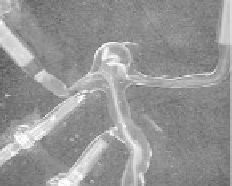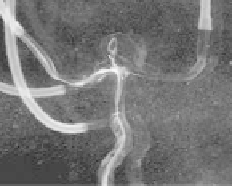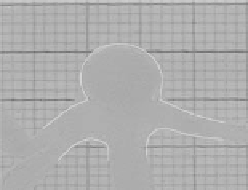Biomedical Engineering Reference
In-Depth Information
Aneursym
Aneursym
a)
b)
Inflow
Inflow
Figure 3.27
Visualized blood stream inside an aneurysm: (a) Block model.
(b) Membranous model.
This experiment shows signiicant result for medicine, as it
has been pointed out that the low in artery changes by the vessel
deformation as shown in Figs. 3.27 and 3.28. The membranous
vascular model shown in Fig. 3.27b reproduces the lexible vascular
wall structure of human. As a result, it reproduces the pulsatile
vascular deformation similar to the living body along with the
pulsatile blood streaming. Additionally it was conirmed that the
membranous vascular model generates a high-speed swirling low
inside aneurysm. On the other hand, the lumen shape hardly deforms
for the solid vascular model of Fig. 3.27a. Under such a condition,
the high-speed swirling low observed for the membranous vascular
model has not appeared in its aneurysm. Thus, this result shows
that the low in blood vessel changes greatly by the existence of
vascular deformation. Then, it is deduced from this result that it
is indispensable to execute blood low analysis to reproduce the
pulsatile deformation of vascular structure. Consequently, it was
conirmed that the proposed patient-speciic cerebral arterial
model with membranous coniguration is the most suitable for
hemodynamic studies and evaluation of medical treatment.
a)
b)
Figure 3.28
Deformation of membranous vascular model case No. 2
with the simulated pulsed blood streaming: (a) Diastole, (b)
Systole.




























































Search WWH ::

Custom Search